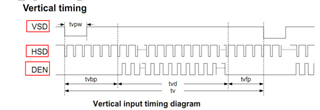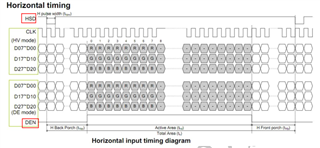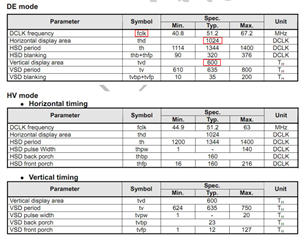Tool/software:
Hi, Ti
When I display solid color pictures, the LCD display is normal, when I display complex pictures, a blurry screen occurs.




This thread has been locked.
If you have a related question, please click the "Ask a related question" button in the top right corner. The newly created question will be automatically linked to this question.
Tool/software:
Hi, Ti
When I display solid color pictures, the LCD display is normal, when I display complex pictures, a blurry screen occurs.




Hi,
How are you displaying the picture? Is it Linux or RTOS? What frameworks are you using?
Regards,
Krunal
I use Linux to display the picture, the display driver is tidss, the panel driver is simple-panel.c. And I use libjpeg to display these jpg images.
Do you see similar behavior with Qt+Weston or Gstreamer? I am trying to isolate if the issue is with libjpeg or DSS setting.
Regards,
Krunal
Hi,
What SDK baseline are you on and what changes have you made to your DT files? Also, have you probed the clocks and the data lines to ensure everything is latching on rising edge or falling edge and lcd timing are based on your LCD specs.
Regards,
Krunal
Hi,
1. The sdk is ti-processor-sdk-linux-am62xx-evm-09.02.01.10, the kernel source code is ti-linux-kernel-6.1.83
2. The changes to the DT file are as follows:
/ {
backlight_rgb: backlight-rgb {
compatible = "pwm-backlight";
pwms = <&epwm1 0 20000 0>;
brightness-levels = <
0 20 20 21 21 22 22 23
23 24 24 25 25 26 26 27
27 28 28 29 29 30 30 31
31 32 32 33 33 34 34 35
35 36 36 37 37 38 38 39
40 41 42 43 44 45 46 47
48 49 50 51 52 53 54 55
56 57 58 59 60 61 62 63
64 65 66 67 68 69 70 71
72 73 74 75 76 77 78 79
80 81 82 83 84 85 86 87
88 89 90 91 92 93 94 95
96 97 98 99 100 101 102 103
104 105 106 107 108 109 110 111
112 113 114 115 116 117 118 119
120 121 122 123 124 125 126 127
128 129 130 131 132 133 134 135
136 137 138 139 140 141 142 143
144 145 146 147 148 149 150 151
152 153 154 155 156 157 158 159
160 161 162 163 164 165 166 167
168 169 170 171 172 173 174 175
176 177 178 179 180 181 182 183
184 185 186 187 188 189 190 191
192 193 194 195 196 197 198 199
200 201 202 203 204 205 206 207
208 209 210 211 212 213 214 215
216 217 218 219 220 221 222 223
224 225 226 227 228 229 230 231
232 233 234 235 236 237 238 239
240 241 242 243 244 245 246 247
248 249 250 251 252 253 254 255
>;
power-supply = <&vdd_pwm>;
default-brightness-level = <200>;
is-forlinx;
status = "okay";
};
panel_rgb: panel-rgb {
compatible = "name,lcd-rgb", "panel-dpi";
backlight = <&backlight_rgb>;
status = "okay";
pinctrl-names = "default";
pinctrl-0 = <&lcd_crtl_pins_default>;
enable-gpios = <&main_gpio0 43 GPIO_ACTIVE_HIGH>;
port {
rgb_in0: endpoint {
remote-endpoint = <&dpi1_out>;
};
};
};
};
&dss_ports {
#address-cells = <1>;
#size-cells = <0>;
port@1 {
reg = <1>;
dpi1_out: endpoint {
remote-endpoint = <&rgb_in0>;
};
};
};
&epwm1 {
pinctrl-names = "default";
pinctrl-0 = <&main_epwm1_a_pins_default>;
status = "okay";
};
&dss {
pinctrl-names = "default";
pinctrl-0 = <&main_dss0_pins_default>;
status = "okay";
};
3. The changes to the panel-simple.c are as follows:
static const struct drm_display_mode name_mode = {
.clock = 51200,
.hdisplay = 1024,
.hsync_start = 1024 + 160,
.hsync_end = 1024 + 160 + 10,
.htotal = 1024 + 160 + 10 + 160,
.vdisplay = 600,
.vsync_start = 600 + 15,
.vsync_end = 600 + 15 + 1,
.vtotal = 600 + 15 + 1 + 23,
.flags = DRM_MODE_FLAG_NVSYNC | DRM_MODE_FLAG_NHSYNC,
};
static const struct panel_desc name_desc = {
.modes = &name_mode,
.num_modes = 1,
.bpc = 8,
.size = {
.width = 154,
.height = 86,
},
.bus_format = MEDIA_BUS_FMT_RGB888_1X24,
.connector_type = DRM_MODE_CONNECTOR_DPI,
};
4. The LCD data input format and timing are as follows:



5. Measured by an oscilloscope, the data and sync are latching on falling edge
Hi,
By default, data will latch on rising edge and you already implemented the following in your code: https://e2e.ti.com/support/processors-group/processors/f/processors-forum/1228207/am62a7-rgb-display-flickering-and-pixel-issue/4687209#4687209
Also, when you run kmstest, do the output and timing printed on console match your programming?
Regards,
Krunal
Hi,
We found the cause of the problem: the upper and lower 8 bits of RGB were reversed.